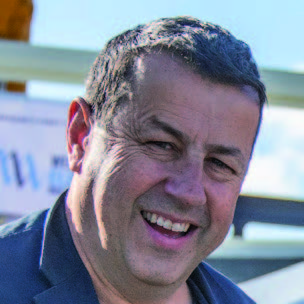Case Study
OVERVIEW
Industry
Industrial > Commercial & Workboats
Target
Fully electric fast passenger ferry
Solution
Full package of analysis, structural design, Hi-Panels, Corecell™, PRIME resin, and other composite materials
Benefits
A lightweight, high performing composite structure to enable electrification and to meet onwater performance goals, as well as a practical and efficient construction approach.
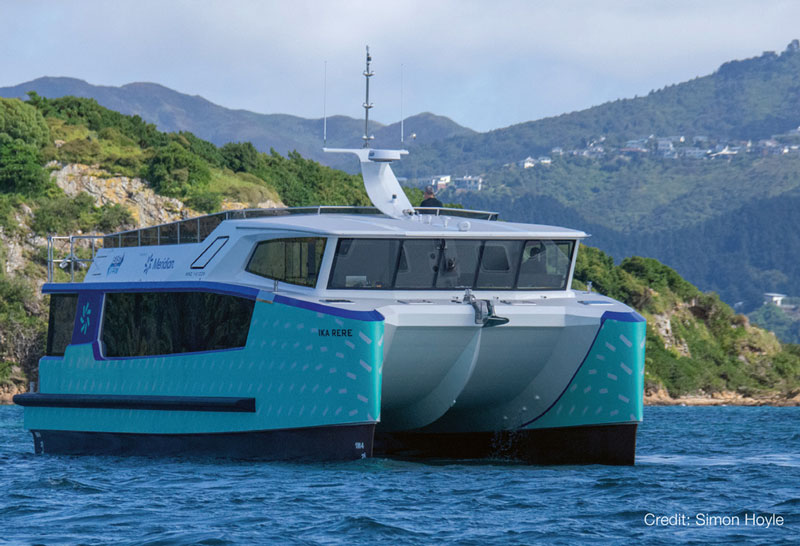
The southern hemisphere’s first fully electric high speed passenger ferry, Ika Rere, was launched in December 2021 by ferry operator East by West Ferries, in Wellington, New Zealand. It was built by Gurit customer Wellington Electric Boat Building Company (WEBBCo).
The 19m catamaran has a passenger capacity of 132 and transports commuters and tourists from Queens Wharf across Wellington Harbour to Days Bay up to 7 times a day, with a service speed of 20 knots. Currently operating with an overnight charge from a 300 kW shore charger, the vessel is future-proofed and ready for local infrastructure upgrades having been designed to be capable of charging at a rate of 1 MW for 15 minutes while passengers disembark and board. Ika Rere runs on 100% renewable energy, provided by NZ electricity provider, Meridian Energy. It was an ambitious electrification project which went straight from the drawing board to commercial operation and relied on close cooperation between numerous maritime experts to bring it to a successful launch. From hydrodynamics to propulsive energy, construction approach to shoreside infrastructure, all areas were designed and developed in tandem with efficiency as the focal point, to ultimately offer East by West Ferries efficiency of operation and long-term returnon- investment, as well as zero operating emissions.
COMPOSITE LIGHTWEIGHTING TO SLASH ENERGY CONSUMPTION
On a conventional commercial ferry, energy consumption followed by maintenance are by far the largest costs for the operator over the life of the vessel and can easily be 4-5 times the purchase price of the ferry. Electric propulsion can significantly reduce operating costs. However, the onboard Energy Storage Systems (ESS) required to achieve the endurance (distance and speed) are typically heavy. This weight in turn increases energy consumption, so a careful balance of providing sufficient energy storage without over burdening the vessel is required. The logical conclusion was to reduce the structural weight of the ferry, so weight became a focal point throughout the design and build process.
ENERGY MODELLING AND COST ANALYSIS TO MEET OPERATIONAL GOALS
Through energy modelling and cost analysis, Gurit evaluated various construction options, with key considerations being displacement, energy consumption, and longevity. It resulted in the selection of high-strength, low-weight carbon fibre as the enabling technology for the electrification of Ika Rere.
This allowed the team to compensate for the weight of the energy and power systems, while still producing a boat that was lighter and therefore more efficient than the industry standard of a diesel aluminium vessel.
Although carbon construction is more expensive than the alternatives of aluminium and traditional fiberglass on a per kg basis, the weight saving offered by carbon fibre means that not only are there fewer kilos of material in the finished product, but the cost of the material can be offset by the reduction in ESS cost, which impacts the initial cost of the vessel as well as ongoing operational costs.
Most significantly, however, is what carbon fibre enables in terms of reduced energy consumption over the life of the vessel. Not only does it enable a zero emission vessel through electrification, but the total energy consumption of the vessel is reduced. East by West Ferries reports a 75% drop in the cost of energy per return trip when using the fully electric Ika Rere compared with one of their diesel ferries.
Weight management approaches were applied by the composite design team throughout the vessel and included features such as heavy multiaxial fabrics to meet the requirements for toughness while reducing manufacturing labour, a robust fendering system was provided to protect the structure from the rigors of docking along side dissimilar wharf structures in exposed locations, and upper deck seats made as structural elements to reduce beams and deck plating weight.
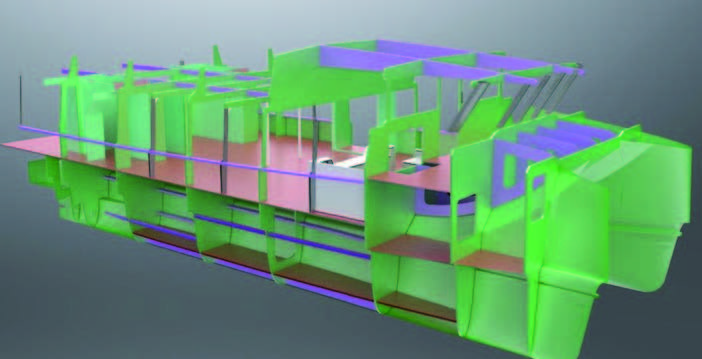
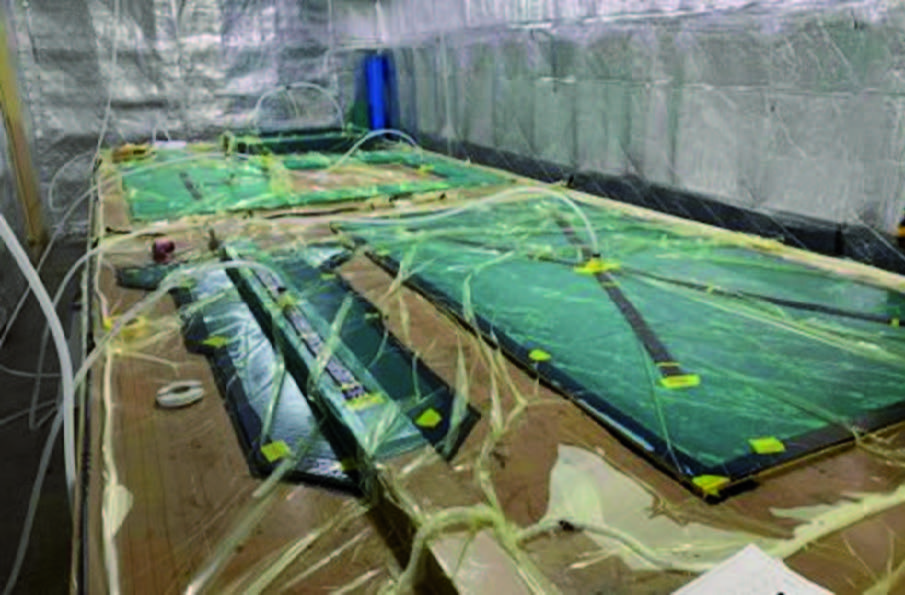
MODULAR CONSTRUCTION FOR COMMERCIAL SUITABILITY
This extreme lightweighting approach is commonplace in the racing yacht world, where winning the race at all costs is the goal. Gurit had the task of bringing this high tech construction approach to a commercial environment. To address this, a modular construction process was developed, with intensive use of digital manufacturing and Gurit Hi-Panels.
The key with digital manufacturing is that all aspects of the design are modeled in 3D – from the vessel geometry to the systems, to the tooling and the jigs. Relying on that single shared point of geometry ensures accuracy. This accuracy allows multiple work fronts to be underway at once and allows a vessel to be split into modules and assembled in almost any order. In the case of Ika Rere, Gurit started with the upper most deck, which was the first item to have its geometry and structure confirmed. This allowed the builder to start fabrication much earlier than if the team had taken the traditional route of starting with the hull.
The carbon fibre and Corecell™ Hi-Panels were laminated and CNC cut, then shipped to WEBBCo for assembly of the vessel’s structure. Not only does this approach meet the requirement for efficient and speedy manufacture, but it also provides flexibility for future builds and minimises the materials consumption for tooling jigs.
LARGE FORMAT INFUSED PANELS KEEP WEIGHT DOWN
To complement the lightweight structural design, large format panels were manufactured that were still easily handled – in this case, 9m long by 2m wide. The size of the panels made for fast assembly and also minimised the parasitic weight from joins. The panels were vacuum infused to ensure accurate resin uptake and avoid excess weight.
For curved areas of the hull, the builder used female moulds along with thermoformed foam core to further reduced resin consumption and weight.
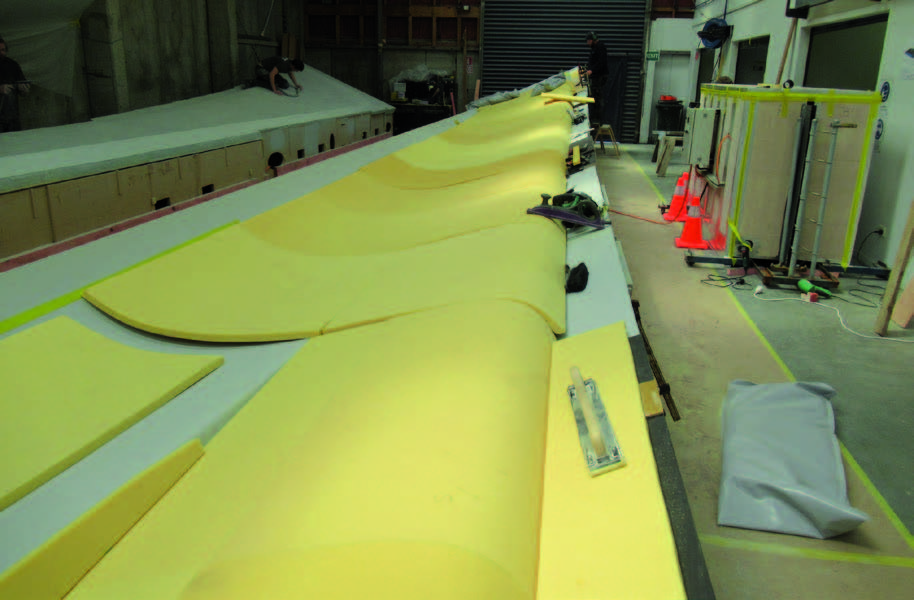
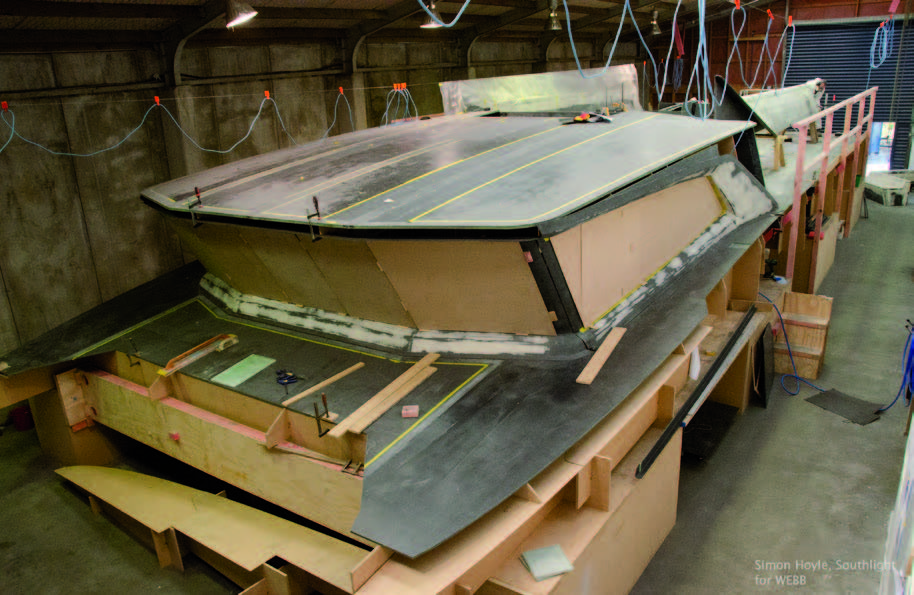
FIRE PROTECTION WITH INNOVATIVE ENGINEERING SOLUTION
To ensure structural stability in the event of a fire in the battery space, Gurit designed an A30 (half-hour) fire boundary using lightweight insulation around the space. This was backed up with a fire-resistant composite structure with an integrated intumescent to protect the structural fibres, combined with a temperature resistant core. Bulkheads were sealed with fireproof glands, and the battery removal hatches feature a labyrinth seal with intumescent surfaces that prevent the outward passage of heat and smoke. Even hatch fasteners are thermally protected to preserve low temperatures on the passenger side of the deck. The battery rack features integrated structural fire protection to limit the spread of a fire between subpacks.
Ika Rere was officially launched in December 2021 and went into service in March 2022. East by West Ferries have been delighted with her on-water performance and the operational efficiencies, and are now considering a second electric ferry for its fleet.
GURIT COMPOSITE MATERIALS & DESIGN RESULTED IN SIGNIFICANT ENVIRONMENTAL AND ECONOMIC BENEFITS FOR THE END USER
- Ika Rere has saved 220,000kg of carbon emissions in the first year of operation
- Having a third of its fleet electrified, East by West Ferries has reduced its total fuel consumption by 40%
- The cost of energy to run a return trip with the electric ferry is just 25% that of a diesel ferry doing the same trip
“WEIGHT WAS A HUGE FOCUS FOR THE DESIGN AND BUILD TEAM THROUGHOUT THE CONSTRUCTION PROCESS. WE WEIGHED EVERYTHING ON THE SHOP FLOOR AND REPORTED NUMBERS BACK TO THE DESIGN TEAM SO WE STAYED ON TRACK. THAT ATTENTION TO DETAIL HAS PAID OFF WHEN WE SEE IKA RERE’S PERFORMANCE ON THE WATER.”
WEBBCo Managing Director, Fraser Foote
